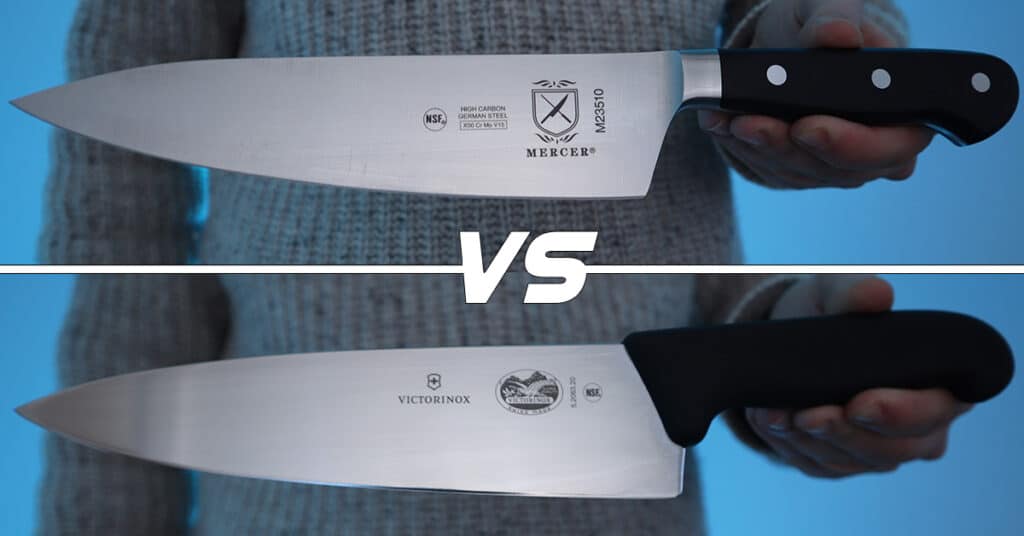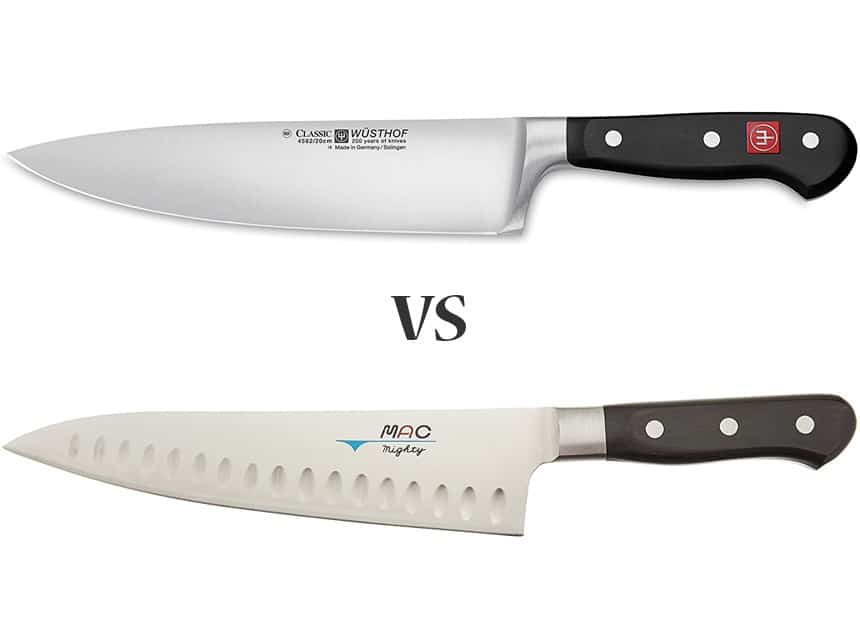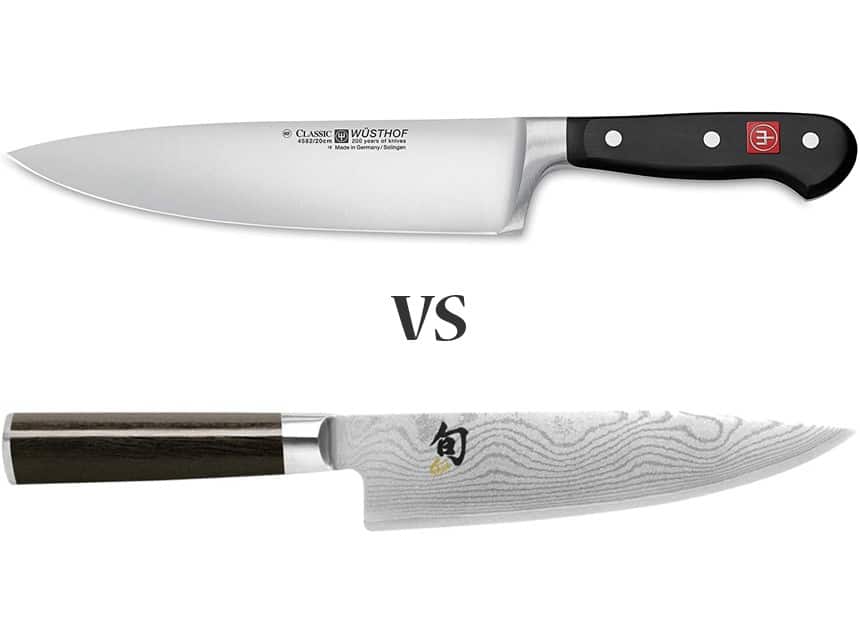
For people looking for a quality knife on a budget, Victorinox and Mercer are two brands you need to take notice of.
I’ve been testing both out in my own kitchen and whilst they both represent great value for money, there are significant differences between the two..
In this article, I’m going to tell you the differences between these two brands. I’ll go in-depth into the details of each, talking about where they are made, what materials are used and the difference in price.
The quick answer
Overall I would recommend the Mercer Renaissance as the best knife between these two brands. For the price of around $50 you get a very well-built knife using high-quality materials.However; The VictorinoxFibrox Pro knife is a great choice for those who prefer a lighter knife as it’s the most lightweight 8-inch chef’s knife I’ve come across.
| My recommendation | Current price |
| Mercer Culinary Renaissance 8-Inch (my pick) | View on Amazon (opens new tab) |
| Victorinox Fibrox Pro Chef’s Knife 8-Inch | View on Amazon (opens new tab) |
Key benefits of Mercer and Victorinox
| Mercer | Victorinox |
| • Forged steel knives with a classic design. • One of the very best brands for low-cost western-style knives. | • The Victorinox Fibrox Pro is the lightest Chef’s knife I’ve ever tested. • Comfortable POM handle with a great textured grip. |
Specifications table
Here is my summary comparison table for each brand. This is mostly based on their main range of knives; the Victorinox Fibrox Pro and the Mercer Renaissance.
For a more in-depth look at each category then check out the rest of the article below.
| Category | Victorinox | Mercer |
| Country of Manufacture | Switzerland | Taiwan |
| Steel type | X50CrMoV15 | X50CrMoV15 |
| Rockwell hardness | HRC 56 | HRC 56-58 |
| Factory edge | 15 degrees (double bevel) | 15 degrees (double bevel) |
| Handle material | TPE (thermoplastic) | POM (thermoplastic) |
| Price range | $50 – $60 (Fibrox Pro) | $50 – $60 (Renaissance) |
| Main benefit | Low price, comfortable design,lightweight | Low price, forged steel, well built |
| My recommendation | Victorinox Chef’s Knife 8-Inch (View on Amazon) | Mercer Renaissance Chef’s Knife 8-Inch (View on Amazon) |
Where are they made
| Brand | Country of manufacture |
| Victorinox | Switzerland |
| Mercer | Taiwan |
Victorinox produces all their knives in Ibach, Switzerland.
Victorinox are a very interesting company as they are the original creators of the Swiss Army Knife, in fact they produce around 45,000 Swiss Army Knives every single day.
The company was founded in 1884 and since then has expanded into other products such as chef’s knives and watches.
I think the practicality that you’d expect from a Swiss Army Knife is reflected in many of the features of Victorinox’s kitchen knives, which certainly focus more on durability than sharpness.
Mercer manufactures their knives in Taiwan, using imported German steel.
Mercer is part of a growing trend in the knife industry of using quality materials, like German or Japanese steel, but basing the manufacture in low cost countries, like China or, in Mercer’s case, Taiwan.
In the past these less authentic brands have been of noticeably lower quality, but more and more these brands are actually producing knives of a comparable standard to their German or Japanese counterparts, for a much lower price.
What steel do they use
The first thing to know is that Victorinox and Mercer actually both use the same steel for their knives, at least in their main range.
However, the way the blade is formed does still make a significant difference between the two.
| Brand | Steel type | Rockwell hardness |
| Victorinox Fibrox Pro | X50CrMoV15 (stamped) | HRC 56 |
| Mercer Renaissance | X50CrMoV15 | HRC 56-58 |
Both these knives use the same steel, X50CrMoV15. However, there is a difference in their Rockwell hardness, with the Mercer knife being the harder of the two.
The main reason for that is that Mercer blades are forged, at least in their Renaissance range, which is a similar cost as the Victorinox Fibrox Pro range that uses stamped steel.
Both the Victorinox and Mercer ranges use X50CrMoV15. It’s a German steel that is popular amongst producers of quality western-style knives. Mercer uses forged steel for its Renaissance range whilst the similarly priced Victorinox Fibrox Pro knives are stamped.
X50CrMoV15 large benefit is its durability, and that’s why it’s so popular with many European knife brands.
The main elements of interest within X50CrMoV15’s composition are Carbon, Vanadium and Chromium.
The Carbon content is around 0.55%. That’s not particularly high when comparing it with other quality knives; however, it’s high enough to provide sufficient strength in the blade for a 15 – 20 degree angle on each side, which is standard for western knives.
The big benefit of not having a very high Carbon content is that higher Carbon steels are usually more brittle, therefore the 0.55% content keeps the blade durable.
That’s the same with the strong Vanadium of 0.4%, Vanadium improves the resistance to wear of the steel also adding to its durability.
The Chromium content is 15% is what the 15 in X50CrMoV15 represents. Chromium is vital for the durability of steel as it’s what makes stainless steel resistant to rust.
Steel need only be 10.5% to be considered stainless, so a 15% content is high and makes this a quality stainless steel, very unlikely to rust unless extremely mistreated by the owner.
There is a difference in the Rockwell hardness (HRC) between the Mercer and Victorinox knives.
Mercer Renaissance knives are forged, that’s when steel is heated to a point it can be moulded.
Victorinox Fibrox Pro knives are stamped. This is when the blade is stamped out of a flat sheet of steel, like a cookie cutter.
Typically forged blades are regarded as better and harder, resulting in the difference on the Rockwell Scale we see here.
However, stamped blades are significantly less expensive, and Victorinox knives still receive the benefits of durability that X50CrMoV15 provides.
Most people would agree that the forged steel of the Mercer is better, especially when you can get either for a similar price.
How sharp are they
You will experience a similar sharpness initially between both Victorinox and Mercer. However; Mercer knives will hold the edge for longer due to the steel being harder.
| Brand | Factory edge | Rockwell hardness |
| Victorinox Fibrox Pro | 15 degrees (double bevel) | HRC 56 |
| Mercer Renaissance | 15 degrees (double bevel) | HRC 56-58 |
Both Mercer and Victorinox use the same type of steel for their main range. However, because forged Mercer Renaissance knives are slightly harder they will hold the edge for longer.
Mercer knives are measured as being slightly harder than Victorinox knives.
That means that whilst they use the same base steel, and are factory sharpened to a similar angle, Mercer knives will be able to hold their edge for longer.
In reality that means you’ll need to sharpen a Victorinox knife more often than you would a Mercer if you want to keep the edge as sharp as possible.
There isn’t a huge amount to choose between the two when measuring sharpness, but overall Mercer wins in this comparison.
What are the handles made from
The material used for handles is a vital and often overlooked feature of any knife.
A quality handle is often the sign of a quality overall knife. Handles need to be made from a durable material that can withstand all the heat and moisture fluctuations knives can experience in the kitchen.
Once again we’ll focus on the two main ranges from each brand, the Victorinox Fibrox Pro and Mercer Renaissance.
| Brand | Handle material |
| Victorinox Fibrox Pro | TPE (thermoplastic) |
| Mercer Renaissance | POM (thermoplastic) |
Both Mercer Renaissance and Victorinox Fibrox Pro use different types of thermoplastic material for their knife handles. Mercer uses POM and Victorinox uses the more flexible TPE.
It is worth mentioning that whilst Victorinox’s most popular range uses TPE, they also have a knife that uses a very attractive Rosewood timber, which is actually my personal Victorinox recommendation.
But as the TPE knives are by far Victorinox’s most popular, I’m focusing on that.
Thermoplastic materials like these are ideal for knife handles due to their extreme durability.
POM is specifically designed for high stiffness and stability, and being a thermoplastic means it’s also extremely resistant to temperature and moisture changes.
It’s a fantastic material to use for knife handles, that will undergo all sorts of pressures and it makes sense to use this material for your main range, which is usually your more practical range.
TPE has many similarities in regard to it being durable, but it has more flex in it than POM.
As a result the TPE handle Victorinox use isn’t quite as tough as the Mercer, but it does offer a good amount of grip.
How much do they cost
Both these brands have a range of knives all at differing price ranges.
To allow for a fairer comparison I’ve categorized two of their major ranges that represent their highest and lowest cost knives.
I’ve tried to compare similar knives, sticking to 8 Inch Chef’s knives or the closest equivalent they have in the range.
In brackets next to the general price range you’ll see the name of the range.
These prices are rough estimates. Prices do change over time but this is intended as a rough guide.
| Brand range | Victorinox | Mercer |
| Standard | $110 – $130 (Professional) | $50 – $60 (Renaissance) |
| Value | $50 – $60 (Fibrox Pro) | $15 – $25 (Millennia) |
This is easily the main benefit of Mercer knives over Victorinox.
I have to say, Mercer does offer a very good product for the price. The very low Millennia range is not going to be as durable as a Victorinox knife, but for the price you would expect it to.
But when you look at the Mercer Renaissance range, as most of this article does, what you get is a knies that is very well built and uses forged steel, whereas the similarly priced Victorinox Fibrox Pro uses stamped steel.
What is the difference
The main difference between Victorinox and Mercer knives is the price. Mercer’s Millennia range is extremely cheap and their Renaissance range uses better materials than the Victorinox’s equally-priced Fibrox Pro.
| Brand | Main benefits |
| Victorinox | Low price, comfortable design, lightweight |
| Mercer | Low price, forged steel, well built |
Both these brands are at the budget end of the scale when it comes to good quality kitchen knives.
But Mercer offers especially good value, no doubt because the manufacturer is based in Taiwan, reducing costs significantly.
For a similar price as a Victorinox Fibrox Pro, Mercer’s Renaissance knife used forged steel instead of stamped and a sturdy POM handle.
Deping on your preference though, the slightly more flexible handle material that the Victorinox Fibrox Pro uses (TPE), does give more grip and so might be preferable.
The stamped steel also makes the Victorinox very lightweight.
Victorinox vs Mercer – Which is better
If you’re choosing between these two brands then my recommendation would be the Mercer Renaissance knife.
It’s very good value for money and the materials used are better than the Victorinox of equal price.
On the plus side for Victorinox, the Fibox Pro range offers more grip on the handle and is more lightweight.
But overall I prefer the Mercer for practicality.
Having said that, Victorinox do offer a very attractive Rosewood handle knife that looks beautiful. It’s a great option if you want a visually striking knife but don’t want to spend too much. I’ve linked to it below.
My Mercer Recommendation

View on Amazon (opens new tab)
Mercer Culinary Renaissance Chef’s Knife Review Table
| Country of manufacture | Taiwan |
| Steel type | X50CrMoV15 (German steel that’s ideal for durability) |
| Rockwell hardness | HRC 56-58 |
| Factory edge | 15 degrees (double bevel) |
| Handle material | POM (thermoplastic) |
| Pros | Durable and low price |
Mercer aren’t a company steeped in history, but the benefit they do have is they produce their knives at a low cost in Taiwan using good quality materials, mixed with good design, to create knives that are up to half the cost of knives using the same materials but produced in Europe.
I’m a fan of Mercer knives and I’ve seen them become slowly more popular because people are genuinely surprised by the quality they offer at such a low price.
The blade uses forged X50CrMoV15 steel with a half bolster, going full tang into the triple riveted handle. It’s a material and design more commonly seen in knife two to three times the price.
The handle is POM, a trusty thermoplastic often used for kitchen knife handles because it’s extremely durable and resistant to most temperature and moisture fluctuations.
Mercer use great materials and classic design for their Renaissance range and I don’t think you could be disappointed with this knife.
My Victorinox Recommendation

View on Amazon (opens new tab)
Victorinox Fibrox Pro Chef’s Knife
| Country of manufacture | Switzerland |
| Steel type | X50CrMoV15 (German steel that’s ideal for durability) |
| Rockwell hardness | HRC 56 |
| Factory edge | 15 degrees (double bevel) |
| Handle material | TPE (thermoplastic) |
| Pros | Durable and lightweight |
If you’re on a budget but still looking for quality then Victorinox are an excellent choice.
Victorinox are a Swiss company founded in 1884. They are the original makers of the world-famous Swiss Army Knife, so they know a thing or two about making sharp blades.
The steel used for this knife is X50CrMoV15, which means it’s strong enough to have a reasonably sharp edge with good edge retention and its 15% Chromium content will prevent it from rusting.
This blade is made using stamped steel, which significantly reduces the cost but means it’s more suitable for home cooks than professionals as stamped blades tend to be less durable than forged.
Since the steel is stamped there is no bolster. The handle is made from a thermoplastic elastomer, making it comfortable and very resistant to moisture and temperature fluctuations.
It’s a lightweight knife, as stamped blades often are and there is a nice curve to the blade edge for rock chopping.
Overall it’s a quality knife for the price, manufactured by a historic producer of knives. It uses great base materials but thanks to the lower production cost it’s affordable even for people a tight budget.

